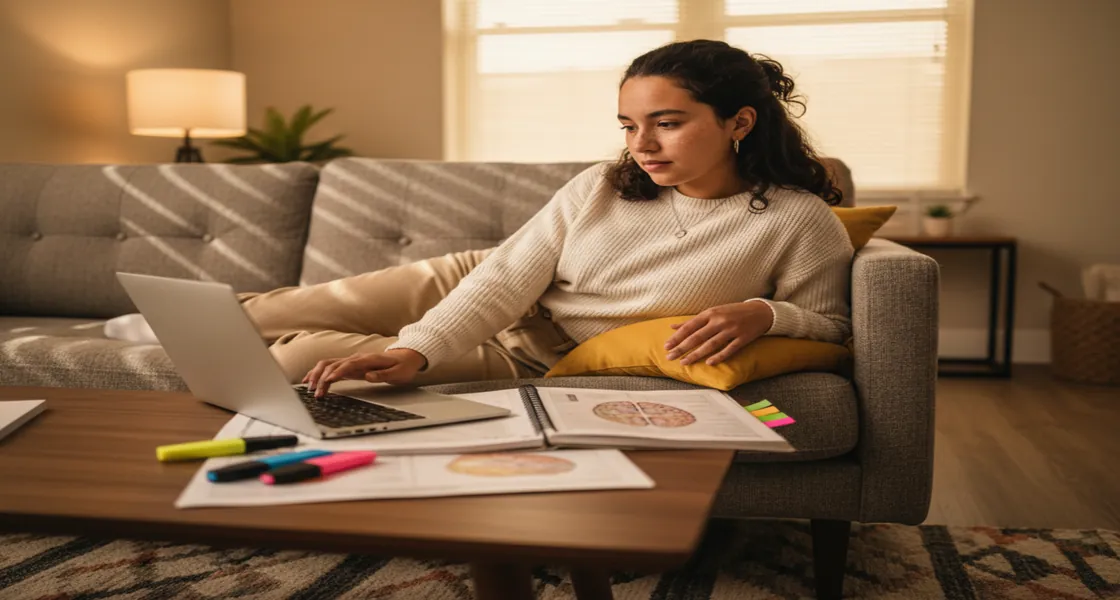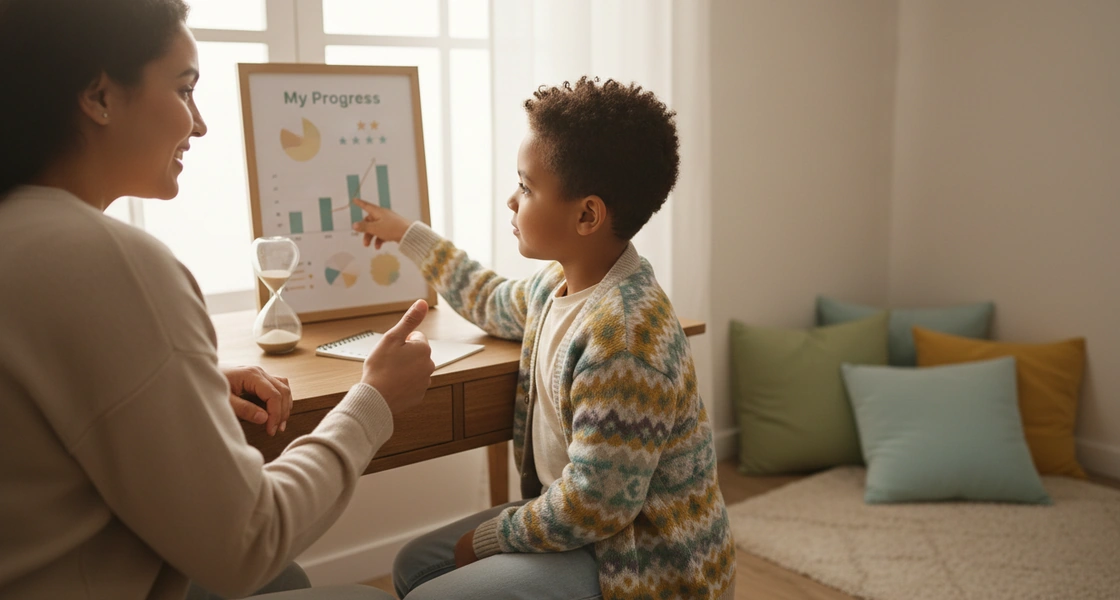As you progress toward teaching your learner the alphabet, one of the first things you might be called to teach is phonics. Phonics is all about tuning in to the sounds that letters make—and helping your learner build the skills to frame words on their own.
Once you start teaching phonics, you’ll quickly realize that they’re everywhere! So all you really need are a few smart strategies and some fun games to get the ball rolling.
In this guide, you’ll find step-by-step ideas, creative activities, and useful tools to support your learner’s reading growth. And if you’d like a little extra backup, Outschool offers phonics classes designed to support every stage of your learner’s journey.
Why phonics matters for your learner’s reading journey
Phonics is about giving your learner the tools they need to figure things out on their own. When they know how to break words apart and put them back together, reading feels much less overwhelming and more fun. Instead of guessing or feeling stuck, your learner can dive into new books, tackle bigger stories, and feel like they’ve got what it takes to keep going.
Here are doors strong phonics skills can open for your learner:
- More confidence with new words.
Instead of guessing or memorizing, your learner can sound out words step-by-step and feel proud about figuring them out.
- A better connection to books.
Your learner begins to see books as something they can explore on their own, making reading that much more exciting.
- Smoother, more fluent reading.
Phonics makes decoding words easier, so your learner can focus more energy on understanding and enjoying stories.
- Skills that grow with them.
Phonics isn’t just for beginners. Sounding out patterns, breaking down words, and recognizing chunks of meaning are skills your learner will keep using as they move into bigger books, writing projects, and beyond.
Every time your learner figures out a new word, they're getting a little quicker, a little braver, and a little more excited to see what they can read next!
How to teach phonics: A step-by-step approach you can use at home
Teaching phonics often goes more smoothly when you have a general path in mind. Doing this sequentially can help your learner build skills step by step, without pressure to rush. It also gives you a clearer sense of when to introduce something new—or when to pause and practice a little longer.
Below is one way to approach phonics at home, with each step building on the last. Feel free to adjust it to fit your learner’s pace and interests:
Step 1: Focus on clear letter sounds
Start with a few simple sounds your learner can really hear and say clearly. It helps to exaggerate the sound a little (“/mmm/ for M”) and pair it with movement or visuals.
Show your learner how to make the sound by describing what you’re doing with your mouth. For example, to explain how to make the /l/ sound, say something like “put your tongue on the roof of your mouth.”
You might trace the letter in the air, make up a silly sound effect, or link it to something familiar ("/sss/ like a snake"). Repeating sounds in different ways helps your learner store them in memory.
Be careful not to add unnecessary sounds to the end of the sound you’re teaching. For example, demonstrate the /p/ sound as /p/ not /puh/.
Step 2: Blend sounds together to make words
Once a few sounds feel familiar, show your learner how to blend them into real words. Stretch out the sounds (“/c/ /a/ /t/”) and then bring them together (“cat!”). Practice with simple, playful words at first. The goal is to help your learner hear how sounds connect naturally.
A little laughter goes a long way here—make up nonsense words, take turns blending silly sounds, and celebrate every “aha” moment.
Step 3: Practice segmenting for stronger spelling
Segmenting is the flip side of blending—it's about pulling words apart into their individual sounds. This helps your learner hear each sound clearly, which supports both reading and spelling.
Start with a short word like “dog.” Say it slowly, and have your learner tap one finger for each sound: /d/ … /o/ … /g/. You can also use blocks, counters, or claps—anything that helps make each sound feel separate and distinct.
Step 4: Introduce familiar sound patterns
Once single sounds are strong, start weaving in common sound combinations like "sh," "ch," and "th." Showing how two letters can team up to make a new sound, and can help them spot those patterns in simple words and stories.
Since these patterns show up everywhere in early reading it’ll make a big difference in your learner’s confidence with reading.
Step 5: Practice with real books
When your learner starts to connect sounds into words, give them chances to apply their skills in real reading. Short, decodable books built around simple sounds are a great way to build fluency without frustration.
Even a few pages of success can make a big difference. Celebrate the effort more than the speed—it’s the steady practice that matters most.
Every day ways to weave phonics practice into your day
Some of the best phonics practice pops up in the middle of everyday life—during quiet moments, quick breaks, or even just while playing around. Just a few minutes here and there can help your learner stay curious and excited to practice.
Here are a few easy, fun ways to keep phonics going naturally:
- Sound scavenger hunt:
Pick a sound and search for things around the house or outside that start with that sound. Turning it into a race can introduce friendly competition and keep the learning spirit going.
- Word-building races:
Grab letter tiles or cards and see how many real (or silly) words your learner can build. For a twist, swap out just one letter at a time to make a new word.
- Storytime sound spotting:
While reading a favorite book, pause every so often and ask your learner to find a word with a target sound. Make it a "sound detective" game and see how many they can catch!
- Hop to the sound:
Scatter letter cards on the floor. Call out a sound, and your learner hops to the right letter. For extra fun, have them shout out a word that starts with that sound when they land.
These little bursts of practice help your learner build stronger skills without it ever feeling like homework. Plus, it keeps reading light, playful, and something they’ll want to come back to again and again.
Helpful resources for phonics practice
Having a few go-to materials ready can make phonics practice feel much easier and more fun for you and your learner. Choosing what works best for your learner can make a big difference. A few well-chosen tools can help with blending sounds, spotting patterns, and growing reading confidence little by little.
Here are some ideas to keep phonics practice fun, fresh, and rewarding at home:
Decodable books
Short, phonics-friendly books give your learner a real chance to practice the sounds and patterns they’ve been working on. Series like Bob Books, Dog on a Log, and The Adventures of Otto are designed to introduce new sounds gradually, which means your learner gets a lot of early success—and a lot more motivation to keep going.
Even a few pages at a time can help your learner feel like a real reader, which builds both skills and confidence in a big way.
Magnetic letters or letter tiles
Hands-on materials like magnetic letters are great for making sounds and words feel more real. Your learner can move the letters around, build new words, and physically see how small changes (like swapping a "b" for a "d") make different sounds.
It's a simple, playful way to practice blending, spelling, and experimenting with sounds—no pencil or paper required.
If you don’t have magnetic tiles, switch them out for something like scrabble’s letter tiles and that should still do the trick.
Printable games and activities
Sometimes, a quick game is all it takes to make a new sound pattern stick. Printable activities like letter-sound bingo, matching cards, or simple phonics board games turn practice into a fun, low-pressure part of your learner’s day.
Games also help keep energy up, which makes it easier to sneak in more practice without it feeling like “more work.”
Live small-group classes and tutoring sessions
Sometimes it helps to have another voice in the mix. Live phonics classes on Outschool give your learner a chance to practice sounds, blending, and spelling with a trained teacher and a few friendly classmates.
Classes like Private Phonics and Reading Tutoring, or Learning to Read! Phonics Based Reading Tutoring offer a step-by-step approach in a playful, supportive setting. Sometimes hearing new sounds modeled clearly—and getting quick feedback—can make tricky skills click faster.
Pick a few resources that fit your learner’s style and keep things moving forward. The goal isn’t to use everything, but to find what keeps practice feeling positive and doable for you and your learner.
Adapting phonics instruction to fit your learner’s needs
Your learner will move through phonics at their own pace—and that's exactly how it should be. Some sounds will click right away. Others might take a little longer, or feel a little tricky at first.
One of the best ways you can support your learner is by staying flexible. When you adjust how you teach based on what your learner needs that day, you make it easier for them to stay curious, confident, and ready to keep trying.
Here are a few ways to keep phonics practice feeling positive and personal:
Adjust the pace when your learner needs more time.
If a sound or pattern feels hard, it’s okay to slow things down. Give your learner time to practice a few words over and over until they feel comfortable. Tiny steps add up—and every bit of practice strengthens the path forward.
Switch up how your learner practices.
If something isn't clicking, a change of pace can make a big difference. Try adding more movement, using colorful visuals, singing out the sounds, or acting them out. Sometimes, a new way of practicing unlocks a skill your learner has been working hard to build.
Let your learner make small choices.
Choosing between two games or picking the next book to read gives your learner a real sense of ownership. Little choices help learning feel like something they’re a part of, not something that’s happening to them.
Celebrate every effort your learner makes.
Each time your learner blends a tough word, spots a sound pattern, or sticks with a challenge, that’s progress worth cheering for. Your encouragement helps them see themselves as strong and capable, even when the work feels big.
Frequently asked questions about teaching phonics
Getting started with phonics at home doesn’t have to be complicated—but it does raise a few common questions. This section breaks down what parents often want to know, with straightforward answers to help you move forward with clarity and ease.
When should I start teaching phonics?
Many children are ready to explore phonics between the ages of 4 and 6, but every learner is different. If your child is beginning to notice letters, ask what words say, or show interest in books and signs, it may be a good time to begin introducing sounds and letters.
What’s the difference between phonics and phonemic awareness?
Phonemic awareness is the ability to hear and play with individual sounds in words—without seeing them written down. Phonics builds on that by connecting those sounds to letters and written words. Both skills are essential parts of early reading development.
How much time should we spend on phonics each day?
Short, consistent practice often works best. Just 10 to 15 minutes a day can make a big difference, especially when it feels relaxed and playful. Quality matters more than quantity—keep the focus on building confidence, not checking boxes.
What if my learner struggles with certain sounds?
It’s completely normal for some sounds to take longer to sink in. If a sound is tricky, slow down and spend more time with it. Use games, songs, or movement-based activities to keep your learner engaged and reduce frustration. Repetition is your friend.
Do I need a formal curriculum to teach phonics?
Not necessarily. Many families find success using simple routines, decodable books, and hands-on tools like letter tiles or apps. The key is consistency and responsiveness—following your learner’s pace and making space for lots of repetition and encouragement.
Where can I find extra support?
If your learner benefits from outside encouragement, Outschool offers live and self-paced phonics classes taught by experienced, engaging teachers. Whether you're looking for one-on-one sessions or small group learning, there are flexible options to meet your learner’s needs.
Helping your learner grow as a reader
Teaching phonics at home is a powerful way to support your learner as they build early reading skills. It gives them the tools to sound out words, make sense of what they see on the page, and approach new texts with more confidence. Strong phonics skills set the stage for fluent reading, clearer writing, and deeper understanding down the line.
If your learner does best with a friendly face and a bit of cheerleading, Outschool’s live and self-paced phonics classes bring the energy, and support that makes reading click.


.svg)
.svg)







